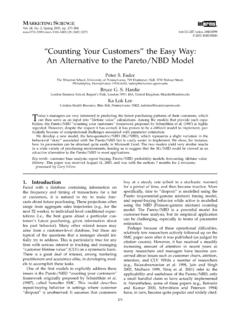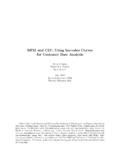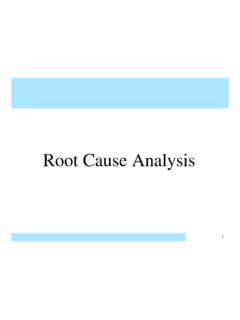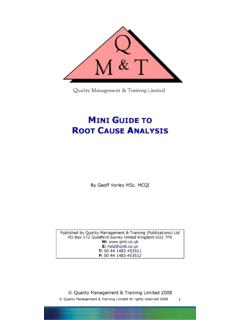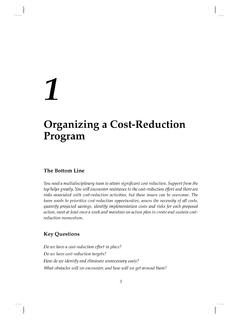Transcription of “Counting Your Customers” the Easy Way: An Alternative to ...
1 counting your Customers the easy Way:An Alternative to the pareto /NBD S. Fader is the Frances and Pei-Yuan Chia Professor of Marketing at the Wharton School of theUniversity of Pennsylvania (address: 749 Huntsman Hall, 3730 Walnut Street, Philadelphia, PA 19104-6340; phone: ; ). Bruce G. is Associate Professor of Marketing, London Business School Ka Lok Lee is a graduate of the Wharton School of the University ofPennsylvania. The first author acknowledges the support of the Wharton-SMU (Singapore ManagementUniversity) Research Center. The second author acknowledges the support of ESRC grant R000223742and the London Business School Centre for counting your Customers the easy Way:An Alternative to the pareto /NBD ModelToday s managers are very interested in predicting the future purchasing patterns of theircustomers, which can then serve as an input into lifetime value calculations. Among themodels that provide such capabilities, the pareto /NBD counting your Customers frameworkproposed by Schmittlein, Morrison, and Colombo (1987) is highly regarded.
2 But despite therespect it has earned, it has proven to be a difficult model to implement, particularly becauseof computational challenges associated with parameter develop a new model, the beta-geometric/NBD (BG/NBD), which represents a slightvariation in the behavioral story associated with the pareto /NBD, but it is vastly easier toimplement. We show, for instance, how its parameters can be obtained quite easily in MicrosoftExcel. The two models yield very similar results in a wide variety of purchasing environments,leading us to suggest that the BG/NBD could be viewed as an attractive Alternative to thePareto/NBD in most : customer Base Analysis, Repeat Buying, pareto /NBD, Probability Models,Forecasting, Lifetime Value1 IntroductionFaced with a database containing information on the frequency and timing of transactions for alist of customers, it is natural to try to make forecasts about future purchasing. These projectionsoften range from aggregate sales trajectories ( , for the next 52 weeks), to individual-levelconditional expectations ( , the best guess about a particular customer s future purchasing,given information about his past behavior).
3 Many other related issues may arise from a customer -level database, but these are typical of the questions that a manager should initially try toaddress. This is particularly true for any firm with serious interest in tracking and managing customer lifetime value (CLV) on a systematic basis. There is a great deal of interest, amongmarketing practitioners and academics alike, in developing models to accomplish these of the first models to explicitly address these issues is the pareto /NBD counting YourCustomers framework originally proposed by Schmittlein, Morrison, and Colombo (1987), here-after SMC. This model describes repeat-buying behavior in settings where customer dropout is unobserved: it assumes that customers buy at a steady rate (albeit in a stochastic manner)for a period of time, and then become inactive. More specifically, time to dropout is modelledusing the pareto (exponential-gamma mixture) timing model, and repeat-buying behavior whileactive is modelled using the NBD (Poisson-gamma mixture) counting model.
4 The pareto /NBDis a powerful model for customer base analysis, but its empirical application can be challenging,especially in terms of parameter because of these operational difficulties, relatively few researchers actively followedup on the SMC paper soon after it was published (as judged by citation counts). But it hasreceived a steadily increasing amount of attention in recent years as many researchers andmanagers have become concerned about issues such as customer churn, attrition, retention, andCLV. While a number of researchers ( , Balasubramanian et al. 1998; Jain and Singh 2002;Mulhern 1999; Niraj et al. 2001) refer to the applicability and usefulness of the pareto /NBD,only a small handful claim to have actually implemented it. Nevertheless, some of these papers( , Reinartz and Kumar 2000; Schmittlein and Peterson 1994) have, in turn, become quitepopular and widely objective of this paper is to develop a new model, the beta-geometric/NBD (BG/NBD),which represents a slight variation in the behavioral story that lies at the heart of SMC soriginal work, but it is vastly easier to implement.
5 We show, for instance, how its parameterscan be obtained quite easily in Microsoft Excel, with no appreciable loss in the model s abilityto fit or predict customer purchasing patterns. We develop the BG/NBD model from firstprinciples, and present the expressions required for making individual-level statements aboutfuture buying behavior. We compare and contrast its performance to that of the pareto /NBDvia a simulation and an illustrative empirical application. The two models yield very similarresults, leading us to suggest that the BG/NBD should be viewed as an attractive alternativeto the pareto /NBD developing the BG/NBD model, we briefly review the pareto /NBD model (Section 2).In Section 3 we outline the assumptions of the BG/NBD model, deriving the key expressionsat the individual-level, and for a randomly-chosen individual, in Sections 4and 5 is followed by the aforementioned simulation and empirical analysis. We conclude with adiscussion of several issues that arise from this The pareto /NBD ModelThe pareto /NBD model is based on five assumptions:i.
6 While active, the number of transactions made by a customer in a time period of lengthtis distributed Poisson with transaction rate .ii. Heterogeneity in transaction rates across customers follows a gamma distribution withshape parameterrand scale parameter .iii. Each customer has an unobserved lifetime of length . This point at which the customerbecomes inactive is distributed exponential with dropout rate .iv. Heterogeneity in dropout rates across customers follows a gamma distribution with shapeparametersand scale parameter .v. The transaction rate and the dropout rate vary independently across pareto /NBD (and, as we will see shortly, the BG/NBD) requires only two pieces ofinformation about each customer s past purchasing history: his recency (when his last trans-action occurred) and frequency (how many transactions he made in a specified time period).The notation used to represent this information is (X=x, tx,T), wherexis the number oftransactions observed in the time period (0,T] andtx(0<tx T) is the time of the lasttransaction.)
7 Using these two key summary statistics, SMC derive expressions for a number ofmanagerially relevant quantities, such as: E[X(t)], the expected number of transactions in a time period of lengtht(SMC, equa-tion 17), which is central to computing the expected transaction volume for the wholecustomer base over time. P(X(t)=x), the probability of observingxtransactions in a time period of lengtht(SMC, equations A40, A43, and A45). E(Y(t)|X=x, tx,T), the expected number of transactions in the period (T,T+t] for anindividual with observed behavior (X=x, tx,T) (SMC, equation 22).The likelihood function associated with the pareto /NBD model is quite complex, involvingnumerous evaluations of the Gaussian hypergeometric function. Besides being unfamiliar to mostmarketing researchers, multiple evaluations of the Gaussian hypergeometric are very demandingfrom a computational standpoint. Furthermore, the precision of some numerical proceduresused to evaluate this function can vary substantially over the parameter space (Lozier and Olver1995); this can cause major problems for numerical optimization routines as they search for themaximum of the likelihood the best of our knowledge, the only published paper reporting a successful implementationof the pareto /NBD model using standard maximum likelihood estimation (MLE) techniques isReinartz and Kumar (2003), and the authors comment on the associated computational an Alternative to MLE, SMC proposed a three-step method-of-moments estimation procedure,which was further refined by Schmittlein and Peterson (1994).)
8 While simpler than MLE, theproposed algorithm is still not easy to implement; furthermore, it does not have the desirablestatistical properties commonly associated with MLE. In contrast, the BG/NBD model, to be3introduced in the next section, can be implemented very quickly and efficiently via MLE, andits parameter estimation does not require any specialized software or the evaluation of anyunconventional mathematical BG/NBD AssumptionsMost aspects of the BG/NBD model directly mirror those of the pareto /NBD. The only differ-ence lies in the story being told about how/when customers become inactive. The pareto timingmodel assumes that dropout can occur at any point in time, independent of the occurrence ofactual purchases. If we assume instead that dropout occurs immediately after a purchase, wecan model this process using the beta-geometric (BG) formally, the BG/NBD model is based on the following five assumptions (the first twoof which are identical to the corresponding pareto /NBD assumptions):i.
9 While active, the number of transactions made by a customer follows a Poisson processwith transaction rate . This is equivalent to assuming that the time between transactionsis distributed exponential with transaction rate , ,f(tj|tj 1; )= e (tj tj 1),tj>tj 1 Heterogeneity in follows a gamma distribution with pdff( |r, )= r r 1e (r), >0.(1)iii. After any transaction, a customer becomes inactive with probabilityp. Therefore thepoint at which the customer drops out is distributed across transactions according to a(shifted) geometric distribution with pmfP(inactive immediately afterjth transaction) =p(1 p)j 1,j=1,2,3,..4iv. Heterogeneity inpfollows a beta distribution with pdff(p|a, b)=pa 1(1 p)b 1B(a, b),0 p 1.(2)whereB(a, b) is the beta function, which can be expressed in terms of gamma functions:B(a, b)= (a) (b)/ (a+b).v. The transaction rate and the dropout probabilitypvary independently across Model Development at the Individual Derivation of the Likelihood FunctionConsider a customer who hadxtransactions in the period (0,T] with the transactions occurringatt1,t2.)
10 ,tx: 0T t1 t2 txWe derive the individual-level likelihood function in the following manner: the likelihood of the first transaction occurring att1is a standard exponential likelihoodcomponent, which equals e t1. the likelihood of the second transaction occurring att2is the probability of remaining activeatt1times the standard exponential likelihood component, which equals (1 p) e (t2 t1).. the likelihood of thexth transaction occurring attxis the probability of remaining ac-tive attx 1times the standard exponential likelihood component, which equals (1 p) e (tx tx 1). the likelihood of observing zero purchases in (tx,T] is the probability the customer becameinactive attx, plus the probability he remained active but made no purchases in thisinterval, which equalsp+(1 p)e (T tx).5 Therefore,L( , p|t1,t2,..,tx,T)= e t1(1 p) e (t2 t1) (1 p) e (tx tx 1){p+(1 p)e (T tx)}=p(1 p)x 1 xe tx+(1 p)x xe TAs pointed out earlier for the pareto /NBD, note that information on the timing of thextrans-actions is not required; a sufficient summary of the customer s purchase history is (X=x, tx,T).)
